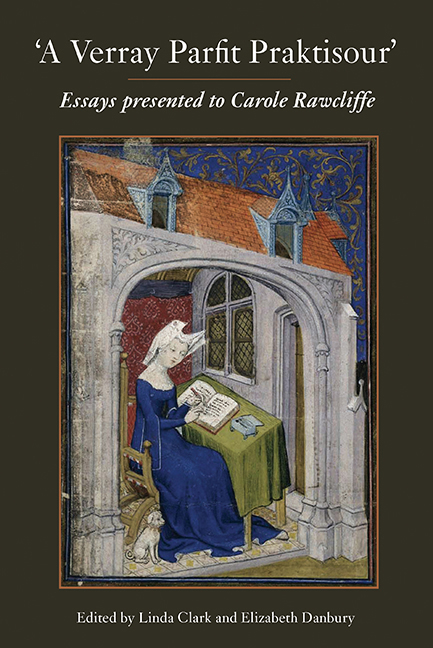Book contents
- Frontmatter
- Contents
- List of Illustrations
- List of Contributors
- Acknowledgements
- Abbreviations
- Tributes
- 1 Coslania, Norwich: an Archaeological Contribution to Early Medieval Urban History
- 2 A Queen in Rebel London, 1215–17
- 3 Defensive Officials and Defensive Levies in Fourteenth-Century Muster Rolls: an East Anglian Perspective
- 4 Lettice Oo? Queen Isabella's Accidental Apothecary
- 5 The First Instrument of Medicine: Diet and Regimens of Health in Late Medieval England
- 6 Politics and Piety: Norwich City Churches, Commemoration and Networking for the Afterlife
- 7 Telling the Time in Chaucer's London
- 8 The Bankrupt Bibliophile, William Paston, 2nd Earl of Yarmouth (1654–1732)
- 9 Ottomans, Neo-Ottomans and Invented Tradition in Hospital Music Therapy
- The Published Works of Carole Rawcliffe, 1976–2016
- Index
- Tabula Gratulatoria
7 - Telling the Time in Chaucer's London
Published online by Cambridge University Press: 09 May 2017
- Frontmatter
- Contents
- List of Illustrations
- List of Contributors
- Acknowledgements
- Abbreviations
- Tributes
- 1 Coslania, Norwich: an Archaeological Contribution to Early Medieval Urban History
- 2 A Queen in Rebel London, 1215–17
- 3 Defensive Officials and Defensive Levies in Fourteenth-Century Muster Rolls: an East Anglian Perspective
- 4 Lettice Oo? Queen Isabella's Accidental Apothecary
- 5 The First Instrument of Medicine: Diet and Regimens of Health in Late Medieval England
- 6 Politics and Piety: Norwich City Churches, Commemoration and Networking for the Afterlife
- 7 Telling the Time in Chaucer's London
- 8 The Bankrupt Bibliophile, William Paston, 2nd Earl of Yarmouth (1654–1732)
- 9 Ottomans, Neo-Ottomans and Invented Tradition in Hospital Music Therapy
- The Published Works of Carole Rawcliffe, 1976–2016
- Index
- Tabula Gratulatoria
Summary
This essay is an attempt to answer a question: why was there no great belfry housing a public clock in medieval London? The Londoners who modelled their new Guildhall in the fifteenth century on the impressive town halls of Ghent and Bruges did not follow these examples and build a great belfry alongside their new civic hall. The invention and use of mechanical clocks to tell the time had been developed in Europe from the twelfth century. The word ‘clock’ signifies a wheeled clock (clockwork) with a pendulum controlled by an escapement. The time (divided into 12/24 hours of equal length day and night) is indicated by a sound made by the clapper/jack on the clock bell and the number of hits indicates the number of hours passed since midnight or midday. So a clock might tell the time aurally or, as time went on, dials were added so that the time could also be told visually. The first documented mechanical clocks seem to have been introduced in ecclesiastical institutions such as cathedrals (for example, the large astronomical clock constructed for Norwich cathedral between 1321 and 1325), and the great Benedictine abbeys. Richard of Wallingford, the famous abbot of St Albans, although stricken with leprosy, was still able to exercise his intellectual skills in the construction of the remarkable St Albans Clock before his death in 1336. But English towns were slow to seize the control of time from the institutions of the Church, although it has been customary to see the use of clock time (merchant time as opposed to Church time) as one of the ways in which secular society came to challenge the controlling influence of ecclesiastical institutions.
Although these new mechanical clocks attached to ecclesiastical buildings may have had a public function, in that the hours they rang could be heard beyond the precincts of the ecclesiastical community, they were controlled by churchmen. The significance of public clocks in Europe has been studied with great erudition by Gerhard Dohrn-van Rossum in his book History of the Hour: Clocks and Modern Temporal Orders, originally published in 1992. He defined a public clock as one which was available to a large number of people, especially city-dwellers, members of a princely residence, the neighbours of a monastery or members of a university.
- Type
- Chapter
- Information
- A Verray Parfit PraktisourEssays presented to Carole Rawcliffe, pp. 141 - 152Publisher: Boydell & BrewerPrint publication year: 2017



